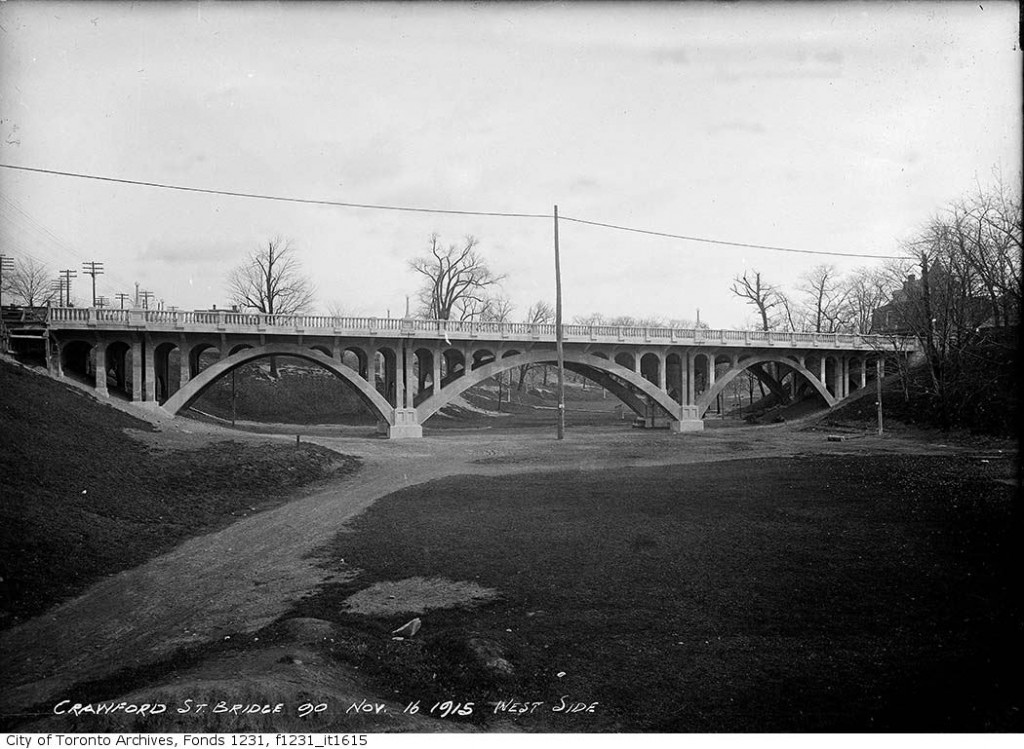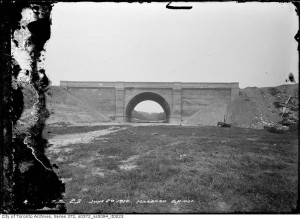Toronto greatest lost river may be buried, but it’s never been dead
This story first appeared in The Globe and Mail on October 29, 2005. The Garrison linkage group and its meetings died shortly thereafter. But Prof. Bernd Baldus hopes to revive things as part of a retirement project. There have been no reports of guerrilla archeology at the Harbord and Crawford bridges.

By STEPHEN WICKENS
Barring a flood of near-biblical proportions, no one will ever again paddle from Fort York to Christie Pits. And the fishing won’t be good any century soon at the Grace Street dip, where London Stream might still empty into Garrison Creek, south of Bloor Street and 10 or so metres underground.
But in certain circles, there’s serious talk of “guerrilla archeology” — digs under cover of darkness to expose parts of the Harbord Street and Crawford Street bridges, the last of at least 20 that once spanned Toronto’s largest buried river.
“It’s to be expected, and it might be a good thing,” James Brown says about the prospect of insurgents armed with shovels roaming Bickford and Trinity Bellwoods parks at night. “People are frustrated.”
At issue is the lack of progress on a project — approved by city council in 1998 — to reconnect the parks and potential parkland of the largely invisible Garrison valley from north of St. Clair Avenue to the lake. It would include bike paths, walking trails and storm-water retention ponds that would be integral to Toronto’s drainage and irrigation.

“This isn’t about nostalgia or mere parkland,” says Mr. Brown of Brown + Storey Architects, who produced the plan with his wife and partner Kim Storey in 1994 — at their own expense — based on decades of research and years of input from scores of community volunteers. “This project is about creating something of real long-term use to the city. Water is an incredibly valuable resource and we have trees dying of thirst, but we still see rain as waste to be disposed of.”
Garrison Creek flows under parks, streets, houses, schools and supermarkets, just as the water does in more than a dozen other buried Toronto streams. It’s largely encased in tunnels we built from the 1860s on, to hide ravines that we had turned into open sewers and dumps for ash and trash.
Some have mused about recreating the early-1800s state of nature that allowed canoes to travel up the creek to Bloor Street. The Garrison project took a more realistic approach, but that might not be enough to save it.
A decade ago, it wasn’t unusual for 400 people to show up at Garrison Creek community meetings. Now, those who have been in for the long haul are drifting away, fearful the project is irretrievably lost in the city’s bureaucracy.
“You can only attend so many public meetings before the lack of tangible progress wears you down,” says committee member Bernd Baldus. “There are some really good and dedicated people at City Hall . . . but, overall, bureaucrats are sucking the life out of this.”
Mr. Brown and Prof. Baldus, a University of Toronto sociologist, say the city missed the point by emphasizing the words “Garrison Creek” through street signs and brass letters set in pavement, rather than the potential of real experience and historical connection.
Prof. Baldus suggests that the city wasted an opportunity last year, when Crawford Street was repaved. “They could have exposed part of the bridge, used some of the original cedar block-style paving, put up railings,” he says. “Until last year, there were clues that a bridge is there. Now, you can’t tell at all. No wonder people talk about guerrilla digs . . . and at Harbord, you need only dig about two feet to really start exposing the span.”
Prof. Baldus got hooked on the Garrison project after picking up a piece of litter on the street. It turned out to be a flyer that said a stream ran under his neighbourhood. He has now been involved for 11 years, but he says he won’t stick around for a 12th unless citizens can reclaim some control from the city, and unless an annual meeting with Councillors Joe Pantalone and Joe Mihevc can be held before each budget period.
“My office is always open to Mr. Baldus; he deserves an award for tenacity,” Mr. Pantalone said. “But on the Crawford Bridge, there was community consultation. There was no majority view that said, ‘Spend $6-million the city doesn’t have to restore the bridge.’ We did ensure the resurfacing was done in a way that, 50 or 100 years from now, should people have the money to unearth it, the bridge will be there. It’s an archeological element — you don’t destroy such things.”
As for public meetings, Mr. Mihevc says it’s likely they will be held.
“The key for this group’s success is to develop bite-sized projects that council, in tight budget years, can sink their teeth into.”
But for all the talk of frustration, there are signs of hope. We may have poisoned and buried our creeks alive, but we never killed Garrison, literally or figuratively.
Earlier this month, more than 200 people showed up dressed in blue for the Human River, a Garrison-tracing hike put on by the Toronto Public Space Committee, the North Toronto Green Community and the Toronto Field Naturalists. The latter two have held “lost river walks” around the city for a decade, teaching people to read the bends and subtle dips in our streets, listen for roars from sewer grates or look for indicator trees such as willows.
Garrison Creek has recently provided artistic inspiration. Stephen Marche’s short story of that title was nominated for an O. Henry Prize in 2002; Erín Moure’s translation of the epic poem Sheep’s Vigil by a Fervent Person, which features references to the buried river, made the 2002 Griffin Poetry Prize shortlist; and Bluemouth Inc. mounted the critically acclaimed play Something About a River in 2003.
Globe and Mail columnist John Bentley Mays wrote in 1994 that “Garrison Creek can lay fair claim to being Toronto’s most famous waterway never seen,” except by an elderly man he had just interviewed.
But in the spring of 2004, running water appeared under a bridge on Bathurst Street, east of Fort York, where Garrison emptied into Lake Ontario from 10,000 years ago until the late 19th century. Fort York administrator David O’Hara, who was with the parks department when the discovery was made, still can’t confirm the water is Garrison Creek. “But we know it’s not coming from a broken water main,” he says, “and it’s not from the sewers — storm or sanitary.”
He says Toronto Community Housing, which plans to build nearby, has a hydrologist on the case. “It sure looks like it’s Garrison, and that’s exciting for us at the fort,” Mr. O’Hara says. “This creek is essential to our history.”
Erin Wood, a Toronto Public Space Committee volunteer who helped organize the Human River walk earlier this month, is among those who only recently became aware of the city’s underground streams and the plight of the Garrison. “It’s amazing to think there are a dozen of these streams in central Toronto alone,” she says. “We’re told Toronto is flat with a grid of streets, but now I see bends and dips — and I know why they’re there.”
And has she heard anything about guerrilla archeology?
“Let’s just say I was involved in some guerrilla gardening this spring. A dig at the Harbord Bridge might be really neat. Who knows?”